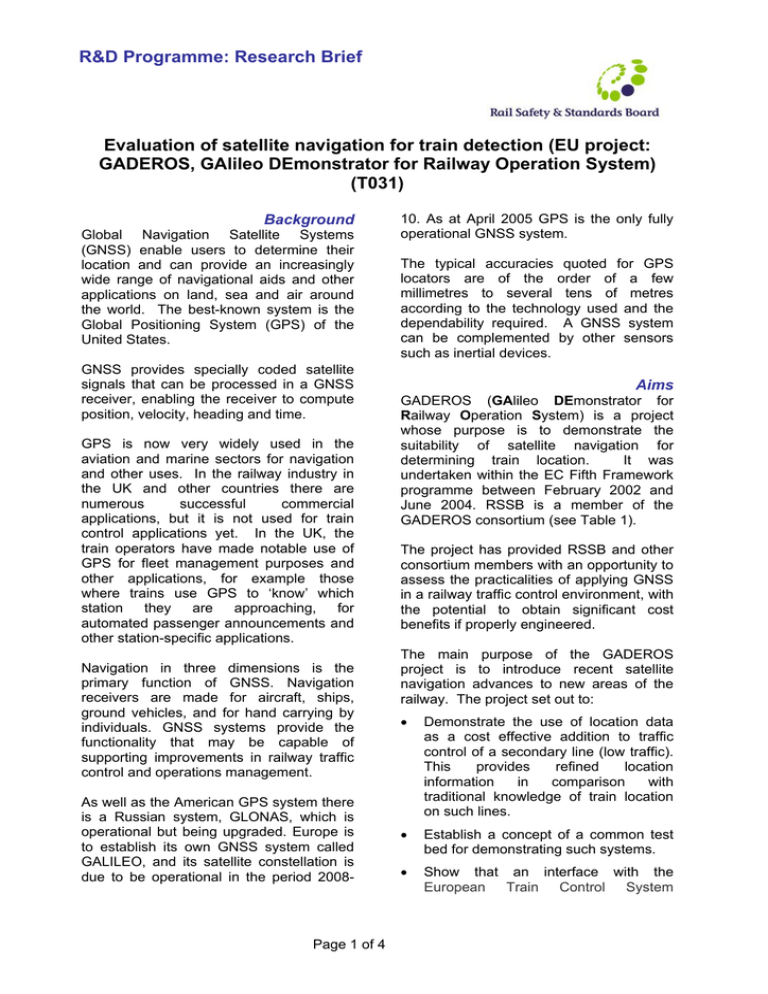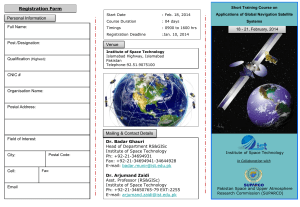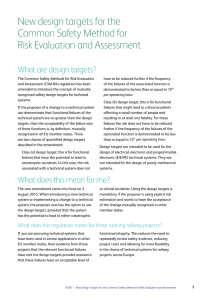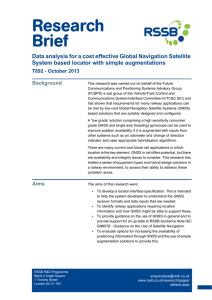R&D Programme: Research Brief GADEROS, GAlileo DEmonstrator for Railway Operation System)
advertisement

R&D Programme: Research Brief Evaluation of satellite navigation for train detection (EU project: GADEROS, GAlileo DEmonstrator for Railway Operation System) (T031) Background Global Navigation Satellite Systems (GNSS) enable users to determine their location and can provide an increasingly wide range of navigational aids and other applications on land, sea and air around the world. The best-known system is the Global Positioning System (GPS) of the United States. GNSS provides specially coded satellite signals that can be processed in a GNSS receiver, enabling the receiver to compute position, velocity, heading and time. GPS is now very widely used in the aviation and marine sectors for navigation and other uses. In the railway industry in the UK and other countries there are numerous successful commercial applications, but it is not used for train control applications yet. In the UK, the train operators have made notable use of GPS for fleet management purposes and other applications, for example those where trains use GPS to ‘know’ which station they are approaching, for automated passenger announcements and other station-specific applications. Navigation in three dimensions is the primary function of GNSS. Navigation receivers are made for aircraft, ships, ground vehicles, and for hand carrying by individuals. GNSS systems provide the functionality that may be capable of supporting improvements in railway traffic control and operations management. As well as the American GPS system there is a Russian system, GLONAS, which is operational but being upgraded. Europe is to establish its own GNSS system called GALILEO, and its satellite constellation is due to be operational in the period 2008- Page 1 of 4 10. As at April 2005 GPS is the only fully operational GNSS system. The typical accuracies quoted for GPS locators are of the order of a few millimetres to several tens of metres according to the technology used and the dependability required. A GNSS system can be complemented by other sensors such as inertial devices. Aims GADEROS (GAlileo DEmonstrator for Railway Operation System) is a project whose purpose is to demonstrate the suitability of satellite navigation for determining train location. It was undertaken within the EC Fifth Framework programme between February 2002 and June 2004. RSSB is a member of the GADEROS consortium (see Table 1). The project has provided RSSB and other consortium members with an opportunity to assess the practicalities of applying GNSS in a railway traffic control environment, with the potential to obtain significant cost benefits if properly engineered. The main purpose of the GADEROS project is to introduce recent satellite navigation advances to new areas of the railway. The project set out to: • Demonstrate the use of location data as a cost effective addition to traffic control of a secondary line (low traffic). This provides refined location information in comparison with traditional knowledge of train location on such lines. • Establish a concept of a common test bed for demonstrating such systems. • Show that an interface with the European Train Control System R&D Programme: Research Brief (ETCS) onboard unit is both possible and useful. This addressed the odometry function and the virtual balise architecture. 3 The GADEROS project needs to be viewed within the context of other European rail research projects involving GNSS. Information about these can be obtained by sending a request for information to research@rssb.co.uk 5 Method RSSB’s role in the consortium was to contribute to the requirements gathering process and to introduce a view of the safety issues associated with GNSS. RSSB was assisted by Nottingham Scientific Ltd (NSL), one of the largest UK consultancies in this field. Based on ‘EGNOS’ receivers and conventional positioning by hybridisation, needs identified by the railways were assessed. Main lines and secondary lines were considered and the constraints affecting them vary widely. The project also produced a demonstration of the application of virtual balises to ETCS. This was developed according to open architecture principles of the current ETCS specifications. The compatibility between the GNSS data and ETCS was demonstrated on the ETCS simulator at the European Rail Research Institute, Utrecht (now closed). The GPS data was collected from the demonstration site, near Madrid. This was provided by the Spanish railway company RENFE. The work consisted packages. These are: WP 1 2 of eight work Evaluation of User needs identification Subsystem functional requirements specification Page 2 of 4 4 6 7 8 Common test requirement specification Test support tool development European Rail Traffic Management System /ETCS Simulation Common trials Evaluation of the results Exploitation and Dissemination In addition the GADEROS report provides: • The results of tests on locators. • Evaluation of the traffic monitoring centre. Findings The GADEROS project met its objectives as described under ‘Aims’. The project demonstrated that Satellite positioning is useable but does depend critically on having the right receiver and locator architecture. Further research is required to optimise these for dependability. The most important finding for RSSB is the theoretical safety basis set out in work package 2. It provides the basis on which to develop this work into a proof of safety. The safety analysis carried out in the onboard location subsystem requirements specification suggests a method of identifying a tolerable hazard rate for the function to be performed by the GNSS location subsystem, so enabling a Safety Integrity Level to be allocated to the different components. The causes of failure for each of them and mitigation strategies are considered. The CENELEC safety standards are applied. The report is not in itself a proof of safety. It considers the causes of inaccuracies and suggests various mitigation strategies. The principles put forward suggest that satisfactory levels of safety should be achievable. Further work is proposed. R&D Programme: Research Brief Next Steps Future work by RSSB in non-safety applications, will facilitate cross-industry collaboration to enable the full benefits of GNSS to be made available to traffic management. In safety applications considerable research is required to establish a firm understanding of the safety issues. This will involve a European strand to deal with the issues relevant to interoperability such as the data communication interfaces and performance requirements. Because it is not possible to participate in interoperability matters from a position of ignorance, a national strand in which safety and related applications are understood and developed is also necessary. Future work needs to address four main areas: 1. Are satellite navigation systems sufficiently dependable in the railway environment? This is in some ways more challenging than the aviation and maritime applications. 2. What complementary technologies are required to support operations during periods when satellite signals are not available? 3. What is the cost/performance potential of train-borne GNSS systems? 4. What applications software is required to enable control centres to deal effectively with data communication? Want more info? A conference on this topic organised by RSSB and Pinpoint Faraday was held at the Institute of Electrical Engineers in London in February 2005. Further information can be obtained by contacting Martyn Thomas at RSSB, martyn.thomas@rssb.co.uk. Page 3 of 4 Contact Jim Lupton Head of Engineering Research Rail Safety and Standards Board research@rssb.co.uk R&D Programme: Research Brief TABLE 1: CONSORTIUM OVERVIEW Organisation Name Country Business Activity / Main Mission / Area of Activity INECO Spain System Engineering and Transport Consultancy Project co-ordinator. Experience in Planning Global and Intermodal Transport Systems Spain Service Provider / Engineering and Transport Consultancy Experience in Railway Transport. Trials in Spain. THALES France Industrial and Research Experience in Radio-navigation Systems and Professional Electronics. Supplier Galileo Locator. ERRI Netherlands Rail Research Institute Experience in Research, Studies and Tests in Railway Technology RSSB UK Safety, Standards and Research Services Experience in Railway Safety Management. Trials in UK. RENFE/ TIFSA Role in Project Sub-contractor of RSSB Consultancy Services Experience in Navigation, Positioning and Info-mobility Technologies. Application Development. NSL UK GMV Spain Experience in Advanced Systems Engineering and and Software Development. Consultancy Studies Second supplier Galileo Locator. SENER Spain Engineering and Experience in Advanced Systems Consultancy Studies and Software Development AENA Spain Service Provider Page 4 of 4 Experience in GNSS and Related Technology. Trials in Spain




